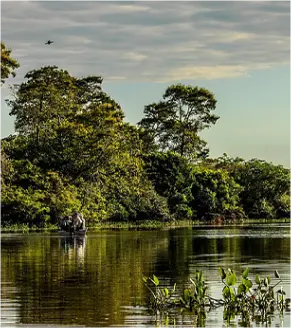$
43.000
, 00
more in yearly donations
138
%
increase in the rehabilitation and reintroduction of jaguars into the Pantanal
15.000
KG
of donated food were provided to the jaguars.




Photographs taken in the Pantanal in 2024

PANTANAL
The Pantanal is the largest continental wetland on the
planet,
spanning approximately 250,000 km² across Brazil, Bolivia, and Paraguay.
In Brazil, over 60% of the Pantanal is located in Mato Grosso do Sul, with the remainder extending into Mato
Grosso.
It is home to more than 1,200 species of vertebrates, including the jaguar, the marsh deer, and the jabiru
stork – the region’s iconic symbol.
Beyond its biodiversity, the Pantanal regulates the hydrological cycle, improves water quality, and acts as
a "natural filter" for the Cerrado and the Amazon.
Protecting the Pantanal is not just an ecological
issue
– it is a climatic, economic, and social necessity.
PANTANAL
WILDFIRES
The fires in the Pantanal have become part of the landscape for
many Brazilians.
In 2023 and 2024, new fires increased the destruction to 80% of the biome (Source: CNN) and 45% of Brazil's
jaguars were directly affected (Source: Forbes),
leaving jaguars increasingly vulnerable due to habitat loss and fragmentation of the areas where they live.
Fires like those of 2020 and 2024 are often ignored in the daily news.
Donations to environmental NGOs fell by 70% in 2024. The jaguar plays an essential role in the ecological
balance of Brazil. That is why it is the focus of preservation and the fight against fires.
As an apex predator, it controls populations in the food chain and maintains the health of ecosystems.
However, this scenario has drastically reduced: in 2022, almost 50% of its population was decimated by
fires, putting the species at risk of extinction and making its preservation a global priority.
Pantanal area
158
km²
Pantanal
burned area
26K
km²























IDEA
We burned all the pages of “Unquiet”, a travel magazine concerned with nature, except
one: the page featuring Onçafari advertisement and sent them to journalists and influencers, ensuring they experienced the tragedy in a sensory way.
The burning process was carefully planned: each page was charred in a controlled manner so that the smell of burning remained,physically conveying the sensation of destruction.
On each sheet, we left charred jaguar paw prints, as if they were traces of the
animals’s desperate escape from the fire. These prints were meticulously crafted, simulating the path of jaguars fleeing for survival amidst the flames.
We packaged each copy, preserving the ashes and creating object that represented both the tragedy and the resistance. Additionally, we expanded the action by taking the burned copies to bookstores and newsstands, allowing the audience to physically interact with the devoted pages and feel the suffering of the jaguars firsthand.

250 pages Included the cover burned.
Except one: the Onçafari ads.
AND SENT THEM TO DOZENS RENOWNED JOURNALISTS AND INFLUENCERS IN BRAZIL.







Onçafari began in August 2011 when its founder and
visionary, former Formula 1 driver Mario Haberfeld, launched operations at Refúgio Ecológico Caiman (REC).
Since 2011, the NGO has collected data and compiled information
to
better understand jaguar behavior and develop improved conservation strategies for the largest feline
in the Americas.
One of the most renowned names in Brazilian journalism,
Joyce Pascowitch has worked as an editor and publisher for major publications and made history as a social
columnist.
Keep donating at
recuperapantanal.com.br








